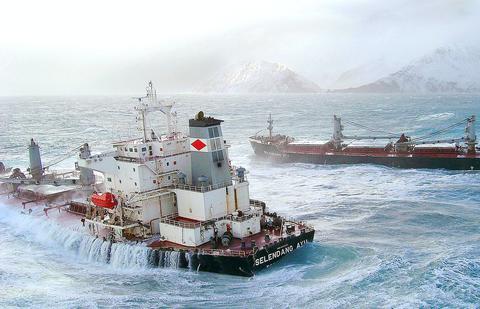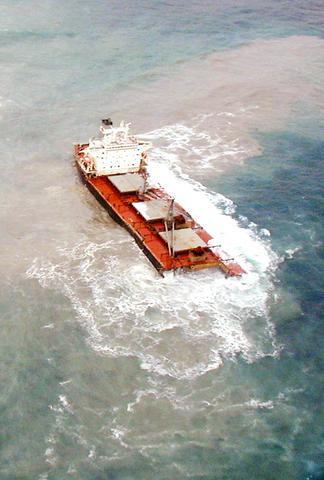Captain Kevin Bell, like others who were on the scene of the monster Exxon Valdez oil spill in Prince William Sound, can still remember it all in haunting detail, 15 years later: the pungent smell, the dead sea otters coated in oil, the thousands of dead birds scooped from the slick black waters and stuffed into plastic garbage bags on the decks of his research vessel.
Horrible and chaotic as it was during the first days after that spill, Bell and his colleagues had one thing going for them then that is eluding those trying to respond to the worst spill in Alaska since the Valdez spilled 4.2 milllion liters of oil in the spring of 1989: They could get there.

PHOTOS: NY TIMES
As Bell, a ship operator for the Alaska Maritime National Wildlife Refuge, prepared to sail his 36.5m vessel, the Tiglax, for the treacherous site of the latest spill near the Aleutian islands in the Bering Sea, one of the most punishing oceans on the planet, he was not optimistic that he could ferry biologists close enough to truly assess the impact of the spill.

"Basically, this is going to be almost impossible," he said.
The situation, the captain said on Sunday, is a mess from top to bottom. Six crew members from a soybean freighter headed from Seattle to China that went aground near the Aleutian island of Unalaska last Wednesday are missing and presumed dead. An unknown amount of the wrecked ship's 1.8 million liters of viscous fuel, which is much harder to break down in the winter cold, may be leaking into one of the world's most remote and ecologically rich wildlife refuges.
The wreck comes at a time when the Bering Sea is at its most restless, with gargantuan swells and gale force winds. And there is precious little daylight. Where the ship broke apart, about 1,200km southwest of Anchorage, endangered or threatened species like sea lions and otters share a delicate habitat with a huge variety of seabirds and waterfowl.
"There are really no words to describe how dangerous this is," Bell, 50, said in a telephone interview from Homer, in Southwest Alaska, where he was readying his vessel for the research mission to the Aleutians.
It is a route he has sailed for 17 years and a trip that, in ideal weather conditions, would take him about three days.
The six missing crew members were lost after a Coast Guard helicopter crashed into the sea after rescuing them from the wreck. The Coast Guard rescuers and one rescued crew member survived the crash. About 20 other crew members survived.
A helicopter with a three-person salvage team took off from nearby Dutch Harbor on Sunday afternoon to undertake the short flight to the 225m-long Selendang Ayu. For days the Coast Guard had wanted to get a team on the vessel to determine how much of the 1.8 million liters of bunker oil and 79,500l of diesel fuel had leaked into the sea.
The salvage team assessed only the stern section of the freighter because it was too difficult to get onto the bow, said Petty Officer Amy Thomas. The team found that the ship's No. 2 hold, which had contained about 150,000l of heavy bunker oil, was breached. When the ship split in half, it was over the No. 2 hold. The Coast Guard has said previously the No. 2 hold contained 530,000 liters of fuel.
``It is completely open to the sea,'' said Petty Officer Amy Thomas.
The No. 3 hold, with an undetermined amount of oil in it, was leaking. The No. 4 hold appeared to be intact. However, three other holds that contained soybeans were breached and ``oozing soybeans,'' she said.
An inspection of the ship's engine room showed that it was completely flooded. A flyover of the area showed about 7,950l of oil on the water's surface, Thomas said.
She said it was still too early to know how much oil and fuel has leaked from the vessel. A team would try again yesterday to board the vessel, Thomas said.
Much of the information on the impact was still speculative or anecdotal, officials said Sunday, but biologists and others had plenty of concerns about the species that inhabit the refuge where the spill occurred.
Greg Siekaniec, manager of the Alaska Maritime National Wildlife Refuge, which covers 4.9 million acres in the Aleutian chain, said the worry was about wintering birds in the area, including the black-legged kittiwake, the harlequin duck, the red-breasted merganser, the red-faced cormorant, the emperor goose and the bald eagle, as well as the Stellar sea lion, an endangered species, and the sea otter, a threatened species, and harbor seals.
The National Transportation Safety Board is investigating the shipwreck and the US Coast Guard is investigating the crash of its helicopter. The Coast Guard is interviewing the 20 surviving crew members of the ship in Dutch Harbor, officials said on Sunday.
Jim Lawrence, spokesman for IMC Shipping, which manages the Selendang Ayu, said the wreck was caused mainly by the bad weather that pushed the Selendang Ayu into shallow waters after its engines failed, despite efforts to halt its movement toward shore. A rescue tugboat that tried to pull the ship to safety was not powerful enough, and the lines between it and the freighter snapped, officials said.

June 2 to June 8 Taiwan’s woodcutters believe that if they see even one speck of red in their cooked rice, no matter how small, an accident is going to happen. Peng Chin-tian (彭錦田) swears that this has proven to be true at every stop during his decades-long career in the logging industry. Along with mining, timber harvesting was once considered the most dangerous profession in Taiwan. Not only were mishaps common during all stages of processing, it was difficult to transport the injured to get medical treatment. Many died during the arduous journey. Peng recounts some of his accidents in

“Why does Taiwan identity decline?”a group of researchers lead by University of Nevada political scientist Austin Wang (王宏恩) asked in a recent paper. After all, it is not difficult to explain the rise in Taiwanese identity after the early 1990s. But no model predicted its decline during the 2016-2018 period, they say. After testing various alternative explanations, Wang et al argue that the fall-off in Taiwanese identity during that period is related to voter hedging based on the performance of the Democratic Progressive Party (DPP). Since the DPP is perceived as the guardian of Taiwan identity, when it performs well,

A short walk beneath the dense Amazon canopy, the forest abruptly opens up. Fallen logs are rotting, the trees grow sparser and the temperature rises in places sunlight hits the ground. This is what 24 years of severe drought looks like in the world’s largest rainforest. But this patch of degraded forest, about the size of a soccer field, is a scientific experiment. Launched in 2000 by Brazilian and British scientists, Esecaflor — short for “Forest Drought Study Project” in Portuguese — set out to simulate a future in which the changing climate could deplete the Amazon of rainfall. It is

Artifacts found at archeological sites in France and Spain along the Bay of Biscay shoreline show that humans have been crafting tools from whale bones since more than 20,000 years ago, illustrating anew the resourcefulness of prehistoric people. The tools, primarily hunting implements such as projectile points, were fashioned from the bones of at least five species of large whales, the researchers said. Bones from sperm whales were the most abundant, followed by fin whales, gray whales, right or bowhead whales — two species indistinguishable with the analytical method used in the study — and blue whales. With seafaring capabilities by humans